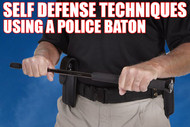Self-defense Techniques Using a Police Baton
Posted by Swordsswords on Oct 5th 2023
While often associated with law enforcement, police batons can also be useful self-defense tools for civilians.
With proper training, a baton allows you to defend yourself without lethal force. In this blog, we will explore various self-defense techniques using a police baton.
From basic blocking and striking moves to more advanced disarming techniques, a baton can help even the odds in a dangerous situation if you know how to use it effectively.
Gripping the Baton
The first step is learning proper baton grip. Most police batons are approximately 26-29 inches long.
Hold the baton firmly but not too tight, with your dominant hand toward the middle and your non-dominant hand near the end for control and power.
Keep your grip loose enough to maneuver the baton quickly and precisely as needed.
Basic Blocking
Blocking is essential for defense. To block an attack, hold the baton horizontally with both hands in front of your centerline. The baton should be positioned to deflect blows away from your body.
You can block high, middle, or low depending on the angle and force of the attack.
Practice smooth, fluid blocking motions to build muscle memory and reaction speed.
Blocking helps create distance and buy time to assess further defense options.
Striking Techniques
If an attacker breaks through your blocks, you may need to strike. Only do so as an absolute last resort to disable a threat.
1.Target major muscle groups like thighs, biceps, and shoulders rather than vital areas.
2.From a basic ready stance, you can deliver straight strikes, hooks, and uppercuts.
3.For maximum power, strike through your target rather than stopping on contact.
4.Be aware of legal restrictions on striking - know your local self-defense laws. De-escalation should always be the first strategy if possible.
Advanced Maneuvers
More experienced baton handlers can try disarming techniques.
If an assailant has a weapon and gets within your reach, you may be able to trap the weapon arm against your body and spin behind them for control.
From there, skilled practitioners can joint lock the arm or take the attacker to the ground to neutralize the threat.
These advanced skills require extensive training and should only be attempted in true life-or-death situations by experts.
For most people, it's best to focus on non-lethal blocking and striking to create an opening to escape to safety.
You can find batons on our website and update your self-defense arsenal today!
Safety Considerations
Always wear protective gear like padded gloves when training. Use a padded practice baton rather than a metal police baton to avoid injury.
Be aware of your surroundings - batons are not suited for enclosed spaces.
Store your baton securely and out of reach of children. Know your local laws regarding carrying or transporting batons.
Can Batons Kill and Break Bones?
While batons are generally considered non-lethal weapons, they still have the potential to cause serious injury or even death in some situations.
Batons are typically made of hard materials like wood or metal, and striking sensitive areas of the body like the head, neck or spine with a baton blow can potentially lead to fractures, internal bleeding or other life-threatening injuries.
According to medical studies, blunt force trauma from a baton strike has the potential to cause concussions, broken bones, organ damage and other harms depending on the amount of force used.
It's also possible for a baton strike to accidentally imp act the throat and cause asphyxiation or other airway issues. However, fatal or life-threatening outcomes from baton strikes are relatively rare compared to other weapons when they are used appropriately and with proper training.
Most police officials strictly regulate baton usage and aim for non-lethal self-defense. With care and responsibility, batons can be a safer alternative to firearms in many law enforcement scenarios.
Conclusion
With proper training, a baton can be an effective non-lethal self-defense tool. It allows you to maintain distance and react quickly through blocking techniques.
Striking is a last option only. More advanced disarming maneuvers require extensive practice and expertise.
Above all, remember that self-defense with a baton still poses risks - it is never the goal to harm an attacker, only to escape safely.
De-escalation, situational awareness, non-violent communication skills, and knowing when to withdraw from a situation are just as important as any physical techniques.
Use judgment in real-world scenarios. A baton alone does not make anyone a martial arts expert overnight.
With care, training and responsibility, it can be one piece of a self-defense strategy.

